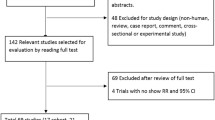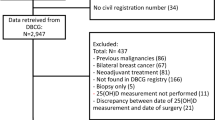Abstract
Despite the emerging literature supporting the beneficial role of vitamin D on various health outcomes including carcinogenesis, current evidence on the association between vitamin D and breast cancer is still largely inconsistent. Furthermore, this relationship is particularly under explored among Asian population. We conducted a large case–control study with Korean women. We obtained and compared serum 25-hydroxyvitamin D (25(OH)D) between breast cancer patients (N = 3634) and general population (N = 17,133). Moreover, we further examined the association between serum 25(OH)D and breast cancer risk stratified by menopausal status and hormone receptor (HR) status of the tumor. Adjusted odds ratio (OR) for breast cancer comparing women with deficient level of serum 25(OH)D to women with sufficient level of serum 25(OH)D was 1.27 [95 % confidence interval (CI) 1.15–1.39]. This association did not significantly vary by menopausal status [pre-menopause: 1.26 (95 % CI 1.09–1.45) vs. post-menopause: 1.25 (95 % CI 1.10–1.41)]. When stratified by HR status, the inverse association remained significant in both positive and negative statuses. However, this association was more pronounced in HR-negative breast cancer, particularly with triple-negative breast cancer patients (1.45, 95 % CI 1.15–1.82). Given the growing burden of breast cancer in Asia and dearth of studies examining the association between vitamin D and breast cancer risk in Asian women thus far, this study provides a meaningful evidence for potential preventive effect of vitamin D on breast cancer for this particular population.

Similar content being viewed by others
References
Jung KW, Won YJ, Kong HJ, Oh CM, Seo HG, Lee JS (2013) Cancer statistics in Korea: incidence, mortality, survival and prevalence in 2010. Cancer Res Treat 45(1):1–14. doi:10.4143/crt.2013.45.1.1
Jemal A, Bray F, Center MM, Ferlay J, Ward E, Forman D (2011) Global cancer statistics. CA Cancer J Clin 61(2):69–90. doi:10.3322/caac.20107
Feldman D, Krishnan AV, Swami S, Giovannucci E, Feldman BJ (2014) The role of vitamin D in reducing cancer risk and progression. Nat Rev Cancer 14 (5):342-357. doi:10.1038/nrc3691 http://www.nature.com/nrc/journal/v14/n5/abs/nrc3691.html#supplementary-information
Chung M, Lee J, Terasawa T, Lau J, Trikalinos TA (2011) Vitamin D with or without calcium supplementation for prevention of cancer and fractures: an updated meta-analysis for the U.S. Preventive Services Task Force. Ann Intern Med 155(12):827–838. doi:10.7326/0003-4819-155-12-201112200-00005
Gallicchio L, Helzlsouer KJ, Chow WH, Freedman DM, Hankinson SE, Hartge P, Hartmuller V, Harvey C, Hayes RB, Horst RL, Koenig KL, Kolonel LN, Laden F, McCullough ML, Parisi D, Purdue MP, Shu XO, Snyder K, Stolzenberg-Solomon RZ, Tworoger SS, Varanasi A, Virtamo J, Wilkens LR, Xiang YB, Yu K, Zeleniuch-Jacquotte A, Zheng W, Abnet CC, Albanes D, Bertrand K, Weinstein SJ (2010) Circulating 25-hydroxyvitamin D and the risk of rarer cancers: design and methods of the Cohort Consortium Vitamin D Pooling Project of Rarer Cancers. Am J Epidemiol 172(1):10–20. doi:10.1093/aje/kwq116
Helzlsouer KJ, Committee VS (2010) Overview of the Cohort Consortium Vitamin D Pooling Project of Rarer Cancers. Am J Epidemiol 172(1):4–9. doi:10.1093/aje/kwq119
Kim Y, Je Y (2014) Vitamin D intake, blood 25(OH)D levels, and breast cancer risk or mortality: a meta-analysis. Br J Cancer 110(11):2772–2784. doi:10.1038/bjc.2014.175
Yin L, Grandi N, Raum E, Haug U, Arndt V, Brenner H (2010) Meta-analysis: serum vitamin D and breast cancer risk. Eur J Cancer 46(12):2196–2205. doi:10.1016/j.ejca.2010.03.037
Holick MF (1990) The use and interpretation of assays for vitamin D and its metabolites. J Nutr 120(Suppl 11):1464–1469
Kawase T, Matsuo K, Suzuki T, Hirose K, Hosono S, Watanabe M, Inagaki M, Iwata H, Tanaka H, Tajima K (2010) Association between vitamin D and calcium intake and breast cancer risk according to menopausal status and receptor status in Japan. Cancer Sci 101(5):1234–1240. doi:10.1111/j.1349-7006.2010.01496.x
Lim JS, Kim KM, Rhee Y, Lim SK (2012) Gender-dependent skeletal effects of vitamin D deficiency in a younger generation. J Clin Endocrinol Metab 97(6):1995–2004. doi:10.1210/jc.2011-3098
Hammond ME, Hayes DF, Dowsett M, Allred DC, Hagerty KL, Badve S, Fitzgibbons PL, Francis G, Goldstein NS, Hayes M, Hicks DG, Lester S, Love R, Mangu PB, McShane L, Miller K, Osborne CK, Paik S, Perlmutter J, Rhodes A, Sasano H, Schwartz JN, Sweep FC, Taube S, Torlakovic EE, Valenstein P, Viale G, Visscher D, Wheeler T, Williams RB, Wittliff JL, Wolff AC (2010) American Society of Clinical Oncology/College of American Pathologists guideline recommendations for immunohistochemical testing of estrogen and progesterone receptors in breast cancer. J Clin Oncol 28(16):2784–2795. doi:10.1200/jco.2009.25.6529
Wolff AC, Hammond ME, Hicks DG, Dowsett M, McShane LM, Allison KH, Allred DC, Bartlett JM, Bilous M, Fitzgibbons P, Hanna W, Jenkins RB, Mangu PB, Paik S, Perez EA, Press MF, Spears PA, Vance GH, Viale G, Hayes DF (2013) Recommendations for human epidermal growth factor receptor 2 testing in breast cancer: American Society of Clinical Oncology/College of American Pathologists clinical practice guideline update. J Clin Oncol 31(31):3997–4013. doi:10.1200/jco.2013.50.9984
Holick MF, Binkley NC, Bischoff-Ferrari HA, Gordon CM, Hanley DA, Heaney RP, Murad MH, Weaver CM, Endocrine S (2011) Evaluation, treatment, and prevention of vitamin D deficiency: an Endocrine Society clinical practice guideline. J Clin Endocrinol Metab 96(7):1911–1930. doi:10.1210/jc.2011-0385
Abbas S, Chang-Claude J, Linseisen J (2009) Plasma 25-hydroxyvitamin D and premenopausal breast cancer risk in a German case-control study. Int J Cancer 124(1):250–255. doi:10.1002/ijc.23904
Abbas S, Linseisen J, Slanger T, Kropp S, Mutschelknauss EJ, Flesch-Janys D, Chang-Claude J (2008) Serum 25-hydroxyvitamin D and risk of post-menopausal breast cancer–results of a large case-control study. Carcinogenesis 29(1):93–99. doi:10.1093/carcin/bgm240
Crew KD, Gammon MD, Steck SE, Hershman DL, Cremers S, Dworakowski E, Shane E, Terry MB, Desai M, Teitelbaum SL, Neugut AI, Santella RM (2009) Association between plasma 25-hydroxyvitamin D and breast cancer risk. Cancer Prev Res (Phila) 2(6):598–604. doi:10.1158/1940-6207.CAPR-08-0138
Lowe LC, Guy M, Mansi JL, Peckitt C, Bliss J, Wilson RG, Colston KW (2005) Plasma 25-hydroxy vitamin D concentrations, vitamin D receptor genotype and breast cancer risk in a UK Caucasian population. Eur J Cancer 41(8):1164–1169. doi:10.1016/j.ejca.2005.01.017
Rossi M, McLaughlin JK, Lagiou P, Bosetti C, Talamini R, Lipworth L, Giacosa A, Montella M, Franceschi S, Negri E, La Vecchia C (2009) Vitamin D intake and breast cancer risk: a case-control study in Italy. Ann Oncol 20(2):374–378. doi:10.1093/annonc/mdn550
Engel P, Fagherazzi G, Boutten A, Dupre T, Mesrine S, Boutron-Ruault MC, Clavel-Chapelon F (2010) Serum 25(OH) vitamin D and risk of breast cancer: a nested case-control study from the French E3N cohort. Cancer Epidemiol Biomark Prev 19(9):2341–2350. doi:10.1158/1055-9965.EPI-10-0264
Lin J, Manson JE, Lee IM, Cook NR, Buring JE, Zhang SM (2007) Intakes of calcium and vitamin D and breast cancer risk in women. Arch Intern Med 167(10):1050–1059. doi:10.1001/archinte.167.10.1050
Rejnmark L, Tietze A, Vestergaard P, Buhl L, Lehbrink M, Heickendorff L, Mosekilde L (2009) Reduced prediagnostic 25-hydroxyvitamin D levels in women with breast cancer: a nested case-control study. Cancer Epidemiol Biomark Prev 18(10):2655–2660. doi:10.1158/1055-9965.EPI-09-0531
Shin MH, Holmes MD, Hankinson SE, Wu K, Colditz GA, Willett WC (2002) Intake of dairy products, calcium, and vitamin d and risk of breast cancer. J Natl Cancer Inst 94(17):1301–1311
Chen P, Hu P, Xie D, Qin Y, Wang F, Wang H (2010) Meta-analysis of vitamin D, calcium and the prevention of breast cancer. Breast Cancer Res Treat 121(2):469–477. doi:10.1007/s10549-009-0593-9
Bertone-Johnson ER (2007) Prospective studies of dietary vitamin D and breast cancer: more questions raised than answered. Nutr Rev 65(10):459–466
McCullough ML, Rodriguez C, Diver WR, Feigelson HS, Stevens VL, Thun MJ, Calle EE (2005) Dairy, calcium, and vitamin D intake and postmenopausal breast cancer risk in the Cancer Prevention Study II Nutrition Cohort. Cancer Epidemiol Biomark Prev 14(12):2898–2904. doi:10.1158/1055-9965.epi-05-0611
Bauer SR, Hankinson SE, Bertone-Johnson ER, Ding EL (2013) Plasma vitamin D levels, menopause, and risk of breast cancer: dose-response meta-analysis of prospective studies. Medicine (Baltimore) 92(3):123–131. doi:10.1097/MD.0b013e3182943bc2
Abbas S, Linseisen J, Chang-Claude J (2007) Dietary vitamin D and calcium intake and premenopausal breast cancer risk in a German case-control study. Nutr Cancer 59(1):54–61. doi:10.1080/01635580701390223
Bertone-Johnson ER, Chen WY, Holick MF, Hollis BW, Colditz GA, Willett WC, Hankinson SE (2005) Plasma 25-hydroxyvitamin D and 1,25-dihydroxyvitamin D and risk of breast cancer. Cancer Epidemiol Biomark Prev 14(8):1991–1997. doi:10.1158/1055-9965.EPI-04-0722
Yao S, Sucheston LE, Millen AE, Johnson CS, Trump DL, Nesline MK, Davis W, Hong CC, McCann SE, Hwang H, Kulkarni S, Edge SB, O’Connor TL, Ambrosone CB (2011) Pretreatment serum concentrations of 25-hydroxyvitamin D and breast cancer prognostic characteristics: a case-control and a case-series study. PLoS ONE 6(2):e17251. doi:10.1371/journal.pone.0017251
Feskanich D, Ma J, Fuchs CS, Kirkner GJ, Hankinson SE, Hollis BW, Giovannucci EL (2004) Plasma vitamin D metabolites and risk of colorectal cancer in women. Cancer Epidemiol Biomark Prev 13(9):1502–1508
Vieth R, Cole DE, Hawker GA, Trang HM, Rubin LA (2001) Wintertime vitamin D insufficiency is common in young Canadian women, and their vitamin D intake does not prevent it. Eur J Clin Nutr 55(12):1091–1097. doi:10.1038/sj.ejcn.1601275
Conflict of interest
The authors declare that they have no conflict of interest.
Author information
Authors and Affiliations
Corresponding authors
Additional information
Seho Park and Dong Hoon Lee have contributed equally to this work.
Electronic supplementary material
Below is the link to the electronic supplementary material.
Rights and permissions
About this article
Cite this article
Park, S., Lee, D.H., Jeon, J.Y. et al. Serum 25-hydroxyvitamin D deficiency and increased risk of breast cancer among Korean women: a case–control study. Breast Cancer Res Treat 152, 147–154 (2015). https://doi.org/10.1007/s10549-015-3433-0
Received:
Accepted:
Published:
Issue Date:
DOI: https://doi.org/10.1007/s10549-015-3433-0




